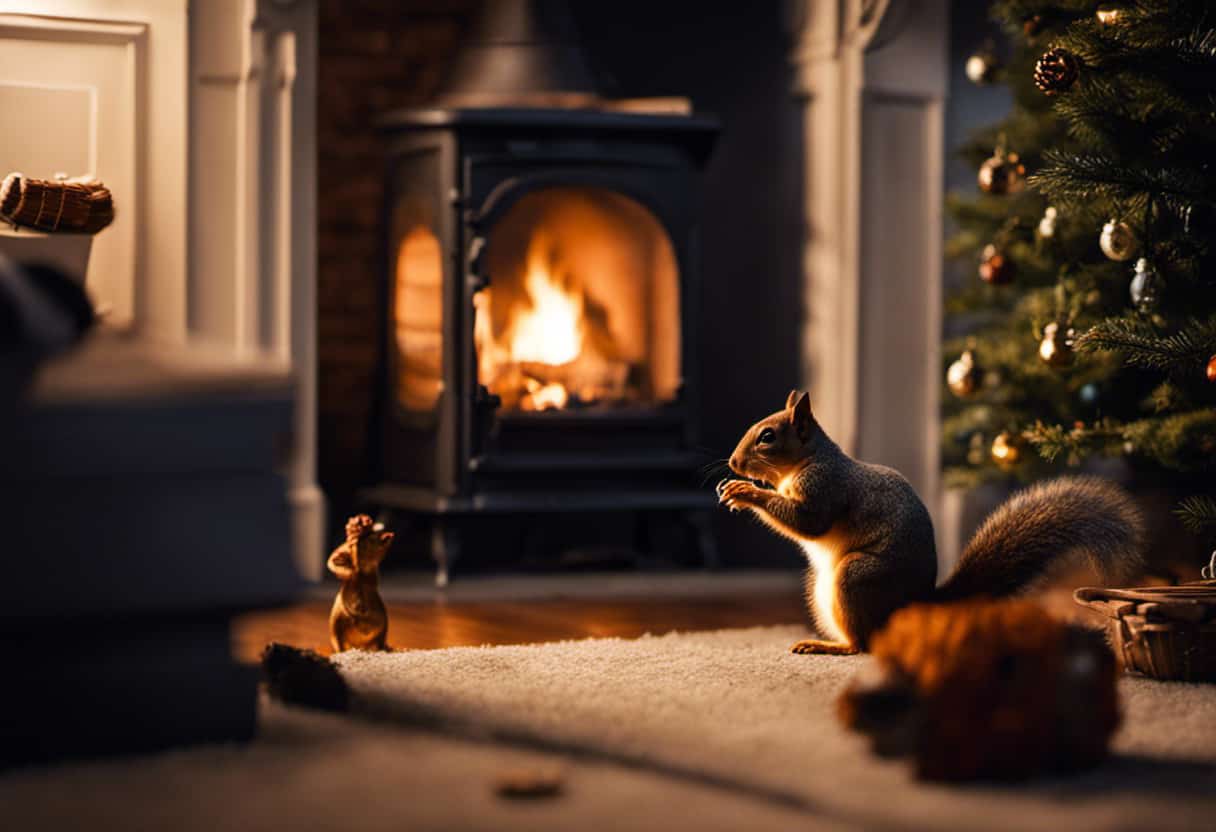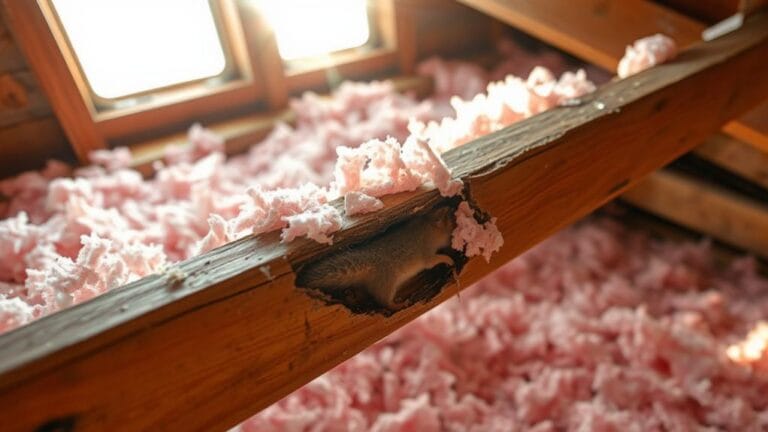Imagine this: you’re cozied up by the fireplace, enjoying a quiet evening, when suddenly you hear scurrying and scratching noises coming from within. Your heart races as you realize there’s a squirrel trapped in your fireplace.
Don’t panic! In this article, we will guide you through the steps to safely and effectively get the squirrel out of your fireplace. With some basic tools and a little know-how, you’ll be able to restore peace to your home in no time.
Key Takeaways
Table of Contents
- Observe squirrel behavior and signs of nesting
- Use a broom or trap to guide or relocate the squirrel
- Squirrel-proof your fireplace with effective methods
- Seek professional assistance if DIY methods fail
Understanding the Behavior of Squirrels
To understand why the squirrel is in your fireplace, you should observe its behavior and look for any signs of nesting. Squirrels are highly social creatures and have a complex communication system. They use vocalizations, body language, and even scent marking to convey messages to each other.
Understanding their social structure can provide insights into why they might seek shelter in your fireplace. Additionally, squirrels have a varied diet and are opportunistic foragers. They primarily eat nuts, seeds, fruits, and insects, but they are also known to raid bird feeders and gardens.
If you have a bird feeder or fruit trees near your home, it could attract squirrels and increase the chances of them entering your fireplace. By understanding their behavior and foraging habits, you can take the necessary steps to safely remove the squirrel from your fireplace.
Assessing the Situation: Is the Squirrel Trapped
When dealing with a trapped squirrel, it’s important to consider the available escape options for the furry intruder. Assess the situation by determining the squirrel’s location, as this will help you devise a plan to safely remove it from your premises.
Squirrel Escape Options
You can use a mesh chimney cap to prevent the squirrel from re-entering your fireplace. This cap will allow smoke to escape while keeping unwanted critters out.
Here are three options to help the squirrel escape and find a new home:
Open all doors and windows: Provide a clear path for the squirrel to exit your home. Create a safe environment by removing any potential obstacles or hazards.
Create an exit route: Use a broom or long object to gently guide the squirrel towards an open door or window. Be patient and give the squirrel time to find its way out.
Use a humane trap: Set up a trap near the fireplace with bait such as nuts or fruit. Once the squirrel enters the trap, relocate it to a suitable outdoor location far away from your home.
Determining Squirrel’s Location
Once the critter is located, it’s important to assess its behavior and determine if it’s safe to approach. Squirrels can be skittish and may become aggressive if they feel threatened. It’s best to observe the squirrel from a distance to gauge its behavior. If the squirrel appears calm and is not exhibiting any signs of aggression, you can proceed with the squirrel removal techniques.
To help you squirrel proof your fireplace, here are some effective methods:
| Technique | Description |
|---|---|
| Install a chimney cap | Prevents squirrels from entering your fireplace through the chimney. |
| Seal any openings | Check for any gaps or cracks and seal them to prevent squirrels from entering. |
| Use deterrents | Place strong-smelling substances like mothballs or predator urine near the fireplace to deter squirrels. |
| Trim nearby branches | Trim any tree branches that are close to your chimney to prevent easy access for squirrels. |
| Regular maintenance | Keep your fireplace and chimney well-maintained to minimize the risk of squirrel entry. |
Gathering the Necessary Tools and Protective Gear
First, make sure you have all the necessary tools and protective gear to safely remove the squirrel from your fireplace. Here are the three items you’ll need:
Thick gloves: Protect your hands from potential scratches or bites while handling the squirrel. Opt for gloves made of durable material, such as leather or thick rubber.
A large towel or blanket: Use this to quickly cover the squirrel once it is out of the fireplace. Wrapping the squirrel in the towel or blanket will help calm it down and make it easier to transport.
A sturdy cardboard box or pet carrier: Once the squirrel is covered, carefully place it in the box or carrier. Make sure it is well-ventilated and secure to prevent any accidental escapes.
Creating an Exit Path for the Squirrel
To help the squirrel find its way out of the fireplace, it’s important to create a clear and accessible exit path. This will allow the squirrel to escape without causing any further damage or harm.
One way to do this is by creating a barrier to prevent the squirrel from entering other areas of your home. You can use a piece of cardboard or a towel to block off any openings or vents.
Additionally, you should open all windows and doors in the room to provide an alternative route for the squirrel to exit.
If these methods fail, it may be necessary to call animal control for professional assistance. They have the experience and tools to safely remove the squirrel from your fireplace.
Using Non-Harmful Deterrents to Encourage the Squirrel to Leave
You can try using non-harmful deterrents, like placing a bowl of vinegar near the fireplace, to encourage the squirrel to leave on its own.
Here are three natural squirrel repellents and DIY squirrel exclusion methods that you can try:
Peppermint oil: Squirrels dislike the strong scent of peppermint oil. Soak cotton balls in peppermint oil and place them near the fireplace. The smell should make the squirrel uncomfortable and encourage it to find another place to nest.
Mothballs: Squirrels are deterred by the strong smell of mothballs. Place a few mothballs near the fireplace, but be sure to keep them out of reach of children and pets. The scent should discourage the squirrel from staying in the area.
Noise and light: Squirrels prefer quiet and dark spaces, so make the area around the fireplace undesirable by creating noise and light. Play loud music or use a bright flashlight near the fireplace to disturb the squirrel’s peace and make it want to leave.
Safely Escorting the Squirrel Out of the Fireplace
Once the squirrel is safely outside of the fireplace, make sure to close the damper to prevent it from reentering. Squirrel removal techniques can be effective in safely escorting the squirrel out of your fireplace.
First, you need to remain calm and avoid sudden movements or loud noises that may startle the squirrel.
Next, open any nearby doors or windows to create an escape route for the squirrel. If the squirrel is hesitant to leave, you can try gently herding it towards the open exit using a broom or a towel.
It is important to remember that squirrels may have nests in chimneys or fireplaces, so it is crucial to inspect and deal with any potential nests once the squirrel is gone. Removing any nests will help prevent future squirrel intrusions and protect your home from potential damage.
Preventing Future Squirrel Intrusions
After safely escorting the squirrel out of the fireplace, it’s important to take steps to prevent future intrusions. Squirrels are persistent creatures, and if they find a way into your home once, they may try again.
To prevent future squirrel damage and keep them out for good, here are three effective strategies:
Seal all entry points: Inspect your home for any openings where squirrels can enter, such as gaps in windows, doors, or vents. Use sturdy materials like wire mesh or caulk to seal these gaps and prevent squirrels from getting in.
Trim tree branches: Squirrels are excellent climbers and can easily access your roof and chimney through overhanging tree branches. Trim back branches that are close to your home to deny them easy access.
Remove food sources: Squirrels are attracted to food, so ensure that there are no open trash cans or easily accessible bird feeders near your home. Secure your garbage cans and consider using squirrel-proof bird feeders to discourage them from sticking around.
Understanding squirrel behavior patterns and implementing these preventative measures will help safeguard your home from future squirrel intrusions.
Seeking Professional Help if Necessary
If the problem persists, it’s advisable to seek professional help to address the squirrel intrusion. While there are several DIY methods to get a squirrel out of your fireplace, sometimes the situation may require the expertise of a professional.
Seeking professional assistance ensures that the removal process is handled safely and effectively, reducing potential dangers for both you and the squirrel.
A professional wildlife removal service will have the knowledge and experience to safely remove the squirrel from your fireplace without causing harm to the animal or damaging your property. They will also be equipped with the necessary tools and equipment to handle the situation efficiently.
Attempting to remove the squirrel on your own can be risky, especially if you are not familiar with proper wildlife handling techniques. Squirrels can become aggressive when cornered or threatened, potentially leading to bites or scratches. Additionally, mishandling the removal process may cause stress or injury to the squirrel.
Frequently Asked Questions
How Do Squirrels End up in Fireplaces in the First Place?
Squirrels can end up in fireplaces due to their natural curiosity and ability to climb. To prevent this, ensure your chimney is properly capped and check for any potential entry points on your roof.
Can Squirrels Cause Any Damage to the Fireplace or Chimney?
Squirrels can cause significant damage to your fireplace and chimney, resulting in expensive repair costs. To prevent squirrel entry, ensure you have a chimney cap installed and seal any potential entry points.
Are There Any Risks or Dangers Involved in Trying to Remove a Squirrel From the Fireplace?
When trying to remove a squirrel from your fireplace, there are risks involved. It’s important to take safety precautions to avoid injury to yourself and the squirrel.
What Are Some Common Mistakes People Make When Trying to Get a Squirrel Out of Their Fireplace?
When trying to get a squirrel out of your fireplace, common mistakes include using improper equipment and blocking escape routes. Avoid these errors by using the right tools and allowing the squirrel a clear path to exit.
How Long Does It Usually Take to Successfully Remove a Squirrel From a Fireplace?
On average, it takes about 1-2 hours to successfully remove a squirrel from a fireplace. Effective techniques include using a humane trap, creating an escape route, and seeking professional help if needed.
Conclusion
In conclusion, you now have the knowledge and tools to safely remove a squirrel from your fireplace.
Remember to assess the situation and gather the necessary gear before creating an exit path for the squirrel.
Use non-harmful deterrents to encourage the squirrel to leave, and safely escort it out of the fireplace.
By taking preventative measures, such as sealing any openings and installing chimney caps, you can minimize the chances of future squirrel intrusions.
If needed, don’t hesitate to seek professional help.
Now go forth and banish those squirrels from your cozy hearth!








